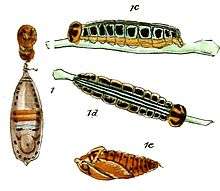Bibasis oedipodea
Bibasis oedipodea, the branded orange awlet,[2] is a species of hesperid butterfly found in South Asia and Southeast Asia. The butterfly was reassigned to the genus Burara by Vane-Wright and de Jong (2003) and is considered by them to be Burara oedipodea.[3]
| Bibasis oedipodea | |
|---|---|
 | |
| From top: male, female and male underside | |
| Scientific classification | |
| Kingdom: | Animalia |
| Phylum: | Arthropoda |
| Class: | Insecta |
| Order: | Lepidoptera |
| Family: | Hesperiidae |
| Genus: | Bibasis |
| Species: | B. oedipodea |
| Binomial name | |
| Bibasis oedipodea | |
| Synonyms | |
|
Ismene oedipodea Swainson, 1820 | |
Range
The branded orange awlet is found in India, Sri Lanka, Myanmar, Malaysia, Java, Thailand and Vietnam.[2][4] In India, the butterfly is found along the Himalayas from Mussoorie to Assam.[2] The type locality is Java in Indonesia.[2][4]
Description

The butterfly has a wingspan of 40 to 50 mm for subspecies ataphus found in Sri Lanka, and of 65 to 70 mm in subspecies excellens found in Sulawesi.[4]
Edward Yerbury Watson (1891) gives a detailed description:[5]
Male. Upperside ochreous olive brown; forewing with an ochreous-red costal band which also extends across base of the cell; a large black basal patch below the cell. Cilia of forewing pale brownish grey, of hindwing ochreous-red.
Female. It differs above only in the absence of the basal black patch, and beneath it in the less prominent white posterior marginal band. Underside ochreous-brown: forewing with a paler ochreous subapical and a marginal fascia, and a broad whitish posterior band: hindwing with bright ochreous red longitudinal streak between the veins, broadest between the median and submedian veins and abdominal margin; a small black spot at the base above the costal vein. Thorax in front, head, palpi, body beneath, and legs ochreous-red; terminal joint of palpi brown.
Host plants
The larva have been recorded on Hiptage benghalensis and Combretum latifolium.[2]
Cited references
- Beccaloni, G.; Scoble, M.; Kitching, I.; Simonsen, T.; Robinson, G.; Pitkin, B.; Hine, A.; Lyal, C., eds. (2003). "Bibasis oedipodea". The Global Lepidoptera Names Index. Natural History Museum. Retrieved April 19, 2018.
- Markku Savela's website on Lepidoptera Page on genus Bibasis.
- Vane-Wright and de Jong (2003) (see TOL web pages on genus Bibasis and genus Burara in the Tree of Life Web Project) state that Bibasis contains just three diurnal species, the crepuscular remainder having been removed to Burara. The species now shifted to Burara are morphologically and behaviorally distinct from Bibasis, within which many authors have formerly included them.
- Evans, W.H. (1932). The Identification of Indian Butterflies (2nd ed.). Mumbai, India: Bombay Natural History Society. pp. 317–318, ser no I 2.6.
- Watson, E. Y. (1891) Hesperiidae indicae.
See also
References
Print
- Evans, W.H. (1932). The Identification of Indian Butterflies (2nd ed.). Mumbai, India: Bombay Natural History Society.
- Watson, E. Y. (1891) Hesperiidae indicae. Vest and Co. Madras.
Online
- Beccaloni, George; Scoble, Malcolm; Kitching, Ian; Simonsen, Thomas; Robinson, Gaden; Pitkin, Brian; Hine, Adrian; Lyal, Chris. "The Global Lepidoptera Names Index (LepIndex)". Natural History Museum, London. Retrieved 2016-10-15.
- Brower, Andrew V. Z. and Warren, Andrew, (2007). Coeliadinae Evans 1937. Version 21 February 2007 (temporary). http://tolweb.org/Coeliadinae/12150/2007.02.21 in The Tree of Life Web Project, http://tolweb.org/
- "Markku Savela's website on Lepidoptera".
